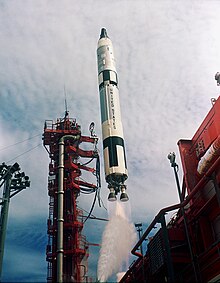Titan II GLV
 Launch of Gemini 11 on a Titan II GLV from LC-19 | |
| Function | Launch vehicle for Gemini manned spacecraft |
|---|---|
| Manufacturer | Martin |
| Country of origin | |
| Size | |
| Height | 109 feet (33.2 m)[1] |
| Diameter | 10 feet (3.05 m) |
| Mass | 340,000 pounds (154,200 kg) |
| Stages | 2 |
| Capacity | |
| Payload to LEO | |
| Mass | 7,900 pounds (3,580 kg) |
| Associated rockets | |
| Family | Titan |
| Launch history | |
| Status | Retired |
| Launch sites | Cape Canaveral LC-19 |
| Total launches | 12 |
| Success(es) | 12 |
| First flight | 8 April 1964 |
| Last flight | 11 November 1966 |
| Type of passengers/cargo | Gemini |
| First stage | |
| Powered by | 1 LR-87 |
| Maximum thrust | 430,000 pounds-force (1,913 kN) |
| Specific impulse | 258 sec |
| Burn time | 156 seconds |
| Propellant | Aerozine 50/dinitrogen tetroxide |
| Second stage | |
| Powered by | 1 LR-91 |
| Maximum thrust | 100,000 pounds-force (445 kN) |
| Specific impulse | 316 sec |
| Burn time | 180 seconds |
| Propellant | A-50/N2O4 |
The Titan II GLV (Gemini Launch Vehicle) or Gemini-Titan II was an American expendable launch system derived from the Titan II missile, which was used to launch twelve Gemini missions for NASA between 1964 and 1966. Two unmanned launches followed by ten manned ones were conducted from Launch Complex 19 at the Cape Canaveral Air Force Station, starting with Gemini 1 on 8 April 1964.
The man-rated Titan II was a liquid-propelled rocket, and consisted of two stages. The first stage was powered by an LR87 engine (although this engine has two combustion chambers and nozzles, it is considered a single unit because both chambers use common turbomachinery), and the second stage was propelled by an LR91 engine.
The rockets were purpose-built for the Gemini launches and featured some modifications compared to the Titan missiles. A malfunction detection system was installed to inform the crew of the rocket's status, and improve response in an emergency. Redundant systems were fitted to reduce the chances of launch failures. The Titan II promised greater reliability than the Atlas because of its hypergolically-fueled engines requiring far fewer components, however various dangers remained, such as the possibility of a guidance malfunction causing the engine nozzles to gimbal hard right/left. For this reason, an extra backup guidance system was added. The second stage propellant tanks were lengthened for longer burn time and unnecessary vernier engines and retro-rockets were removed. Because the second stage engine had had issues with combustion instability, it was equipped with baffled injectors. A radio control system replaced the inertial guidance used on the missiles, and modifications were made to the tracking, electrical and hydraulics systems in the interest of improved reliability. Modifications were overseen by the Air Force Systems Command. Aerojet, the manufacturer of the Titan's engines, had released a revised model during mid-1963 due to deficiencies in the original design and also attempting to improve manufacturing procedures.
Assembly was done at Martin-Marietta's Baltimore plant so as not to interfere with missile work at the Denver facility, although it also saved the former from a planned shutdown.[2]

See also
Notes
- ^ Gatland, Kenneth (1976), Manned Spacecraft (2nd revision ed.), New York: MacMilan, p. 37, ISBN 0-02-542820-9
- ^ http://ntrs.nasa.gov/archive/nasa/casi.ntrs.nasa.gov/19780012208_1978012208.pdf
References
- Krebs, Gunter. "Titan-2-GLV". Gunter's Space Page. Retrieved 2009-04-29.
- Wade, Mark. "Titan". Encyclopedia Astronautica. Retrieved 2009-04-29.
External links
![]() Media related to Titan II Gemini at Wikimedia Commons
Media related to Titan II Gemini at Wikimedia Commons


